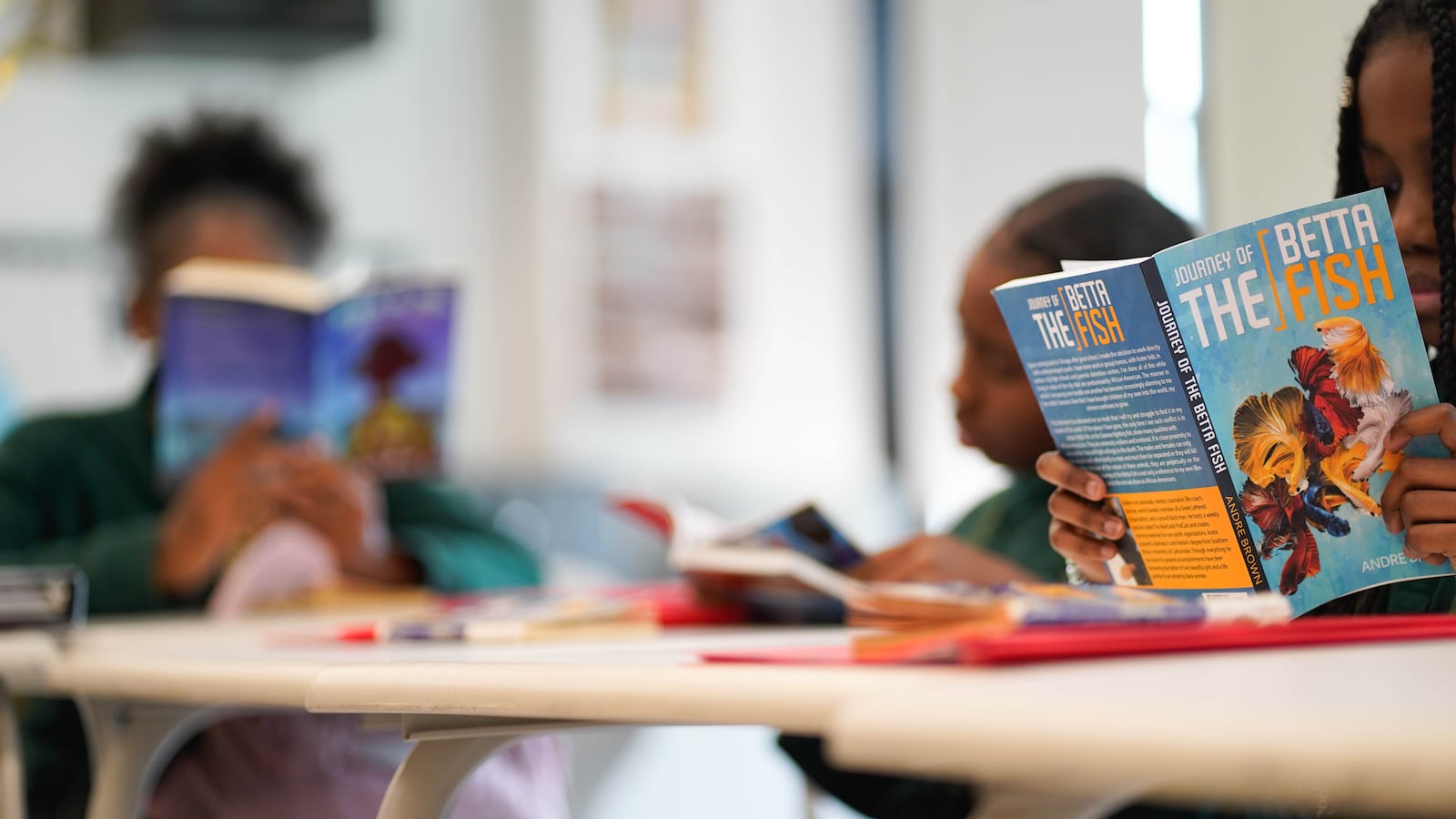Sign up for Chalkbeat Chicago’s free daily newsletter to keep up with the city’s public school system and statewide education policy.
Shortly after Aimee Orta’s daughter started kindergarten in Chicago Public Schools in 2019, the 5-year-old would come home upset and complain about headaches and stomach pain.
The complaints seemed to stem from the little girl’s frustrations with school. After realizing that her daughter might be a struggling reader, Orta decided to get an outside evaluation. The results found that the kindergartener was having trouble matching letters to sounds.
But it would take two more years for Orta’s daughter to be formally diagnosed with dyslexia, her mom says, and for her school on the North West side to provide the academic services she needed. By then, she was in second grade.
Orta said she saw how it impacted her daughter’s social-emotional health.
“She just felt like she wasn’t capable of anything, because when you can’t read you can’t consume any of the other curriculum,” said Orta. “So she’s struggling in math. She’s struggling in science. She’s struggling in social studies.”
The fight to get her daughter the services she needs drove Orta to become an advocate with the CPS Family Dyslexia Collaborative. The group is pushing the district and the state to adopt evidence-based reading instruction in the classroom and to improve interventions for struggling readers and those with dyslexia.
The issue of how to improve literacy instruction has taken on new urgency across the country, as districts grapple with students who fell behind during the pandemic. On the Illinois Assessment of Readiness taken in spring 2023, 25.9% of Chicago students from third to eighth grade who took the exam met or exceeded the standard in English language arts. But for students with disabilities, the percentage dropped to 4.2%.
In recent years, many states have started to revamp how reading is taught by getting rid of a now-debunked reading method called “balanced literacy,” a reading philosophy that believes reading is a natural process, and turning to evidence-based reading instruction.
Illinois has also taken steps to change literacy instruction with the passage of a law that requires the Illinois State Board of Education to create a literacy plan by Jan. 31, 2024. In June, the state board released an initial draft of the plan, which says universal screening for literacy skills is essential and aspiring teachers need to be trained in the science of reading.
However, because the draft plan does not mandate districts to change how reading is taught in classrooms, literacy advocates worry that it is not enough to push schools to get rid of balanced literacy.
The state board plans to release a second draft of the literacy plan during the board’s monthly meeting on Oct. 18. The board also said that it will update the state’s dyslexia handbook this fall — a document that helps parents, educators, school administration understand what dyslexia is and how to support students. The handbook was last updated in 2019.
Parents like Orta and advocates like Jessica Handy, executive director of Stand for Children Illinois and a key author of the literacy bill, say the state’s literacy draft plan needs more work to address the needs of struggling readers and those with dyslexia. Having a strong reading curriculum and evidence-based instruction is good for all readers, Handy said, but students with dyslexia need more support in a classroom setting.
“Students with dyslexia deserve early identification and support instead of waiting for them to fail,” Handy said.
Advocate fight to change Illinois’ literacy instruction
In early 2022, the Illinois Early Literacy Coalition — a group of literacy advocates across the state — pushed legislation to mandate evidence-based reading instruction in all Illinois school districts. The so-called “Right to Read” Act required the state board to create literacy grants, change teacher licensure tests for elementary school teachers, and develop professional development opportunities for current teachers. The proposed law came at a time when the state’s 2021 test scores found that young students had lost ground in English language arts and math.
Many education advocates supported the bill, but critics said it did not address the needs of English language learners — a student group that makes up 14% of the state’s student enrollment. Despite negotiations, the bill did not pass.
But a year later, at the start of 2023, parts of the “Right to Read” Act appeared in several pieces of legislation in the state House and Senate. The group of bills — referred to by advocates as the “Literacy and Justice for All” package — would have required the state to create a literacy plan, design a rubric for school districts to score their reading curriculum, create professional development opportunities for current teachers, and require aspiring teachers to take courses in evidence-based literacy instruction in teacher prep programs.
Literacy advocates also fought for a bill that would have required public schools to screen all students in kindergarten through second grade for dyslexia.
Illinois is one of several states that does not require schools to screen children. Some school districts across the nation have implemented universal screeners for young learners. A spokesperson for Chicago Public Schools said the i-Ready exam, an assessment for all kindergarten through second grade students, has a dyslexia screener.
But despite the push to mandate better reading instruction, train teachers on evidence-based practices, and screen students for dyslexia early, state lawmakers only passed SB 2243. which required the state to create a literacy plan.
The draft plan, which was released in June before the law was signed by Gov. J.B. Pritzker, provides a roadmap for educators to teach reading to students from birth to 12th grade using research-based reading strategies. The draft plan also tells educators how to adjust their instruction to meet the needs of students with disabilities and English language learners.
The plan does outline how state leaders, school districts, and educators should work with students with disabilities, which would include students with dyslexia. But the Illinois Early Literacy Coalition, in a letter to the state board in June, said students with dyslexia deserve their own section and more than “a passing reference” to the dyslexia handbook.
“We know that many students who struggle to read do not have dyslexia and we have strongly supported a plan that is comprehensive and inclusive,” the coalition wrote in its letter. “At the same time, a plan that does not include any specific discussion about students with dyslexia is not inclusive.”
Aspiring teachers need training on phonics

By the spring of 2021, Orta’s daughter was in the second half of first grade and had an Individualized Education Program, or IEP, that required her to get more reading instruction inside her classroom throughout the day.
But Orta soon realized it was not enough. Her daughter needed time outside of her general education classroom to focus on reading strategies. Orta had to push her daughter’s general education teacher and school administration for more help.
“When teachers tell parents, ‘oh, it’ll eventually click’ or ‘we need to wait and see,’ or ‘it’ll be fine.’ When we hear that, we start to doubt our instincts,” said Orta.
A spokesperson for Chicago Public Schools said the district has developed its Skyline English language arts curriculum using evidence-based reading strategies and plans to roll out more curricular support for schools this year. The district announced the curriculum in May 2019 and started rolling it out at schools in 2021. Many, but not all schools have adopted the curriculum.
Requiring evidence-based reading practices is just one part of the solution, advocates and experts say. Better teaching preparation in reading instruction is also needed.
The state board’s draft literacy plan addresses that by suggesting that teacher preparation programs should help aspiring elementary school teachers learn about the science behind reading, understand national and state standards for reading for each grade level, find strategies to help students learn how to read, and use assessments to find where students are struggling to read.
The draft literacy plan also recommends that state leaders work with teacher preparation programs to ensure that curriculum aligns with evidence-based reading practice.
Some evidence shows teacher preparation programs across the nation are still largely teaching future elementary school teachers balanced literacy reading strategies and curriculum, according to a June report from the National Center for Teacher Quality — a nonprofit organization evaluating teacher prep programs.
The report reviewed 16 teacher prep programs in Illinois; of those, eight programs did not spend any course time on helping preservice teachers to teach reading to struggling readers. Nine of Illinois’ teacher prep programs received an F grade. Only two universities, Illinois College and Olivet Nazarene University, received an A+.
However, higher education leaders have criticized the report for grading schools on course material without reaching out to teacher prep programs. The council had to change the grade of at least 24 schools in the nation. Ball State University in Indiana went from a F grade to an A.
Heather Peske, president of NCTQ, said Illinois has too many children who are not reading at grade level and better teacher preparation can change that reality for all students.
“We shouldn’t depend on the families of children who have dyslexia to advocate for their children to be taught aligned to the science and the research,” said Peske. “We need teachers who understand the science of reading, understand the research, and who know how to serve students who have dyslexia.”
Peske noted that Colorado and Mississippi have teacher preparation programs using the science of reading in their curriculum and students have seen a boost in their reading scores.
Literacy advocates look to the future
One year after Orta’s daughter was diagnosed with dyslexia, Orta noticed her catching up to peers. In addition to getting more support at school, she received after-school tutoring and went to a summer school program that focused on reading.
Now, as a fourth grader, the girl is reading just shy of her grade level and enjoys reading for pleasure despite the effort it takes.
Orta has used the lessons learned in her daughter’s journey to help her younger son. She noticed that he struggled to read as well and quickly sought an outside evaluation. He was diagnosed immediately with dyslexia and given an IEP by the end of kindergarten in the spring of 2022.
Orta’s son, now in second grade, has been making progress in reading faster and his social-emotional health is strong.
The state literacy plan recommends, but doesn’t mandate, that schools use universal screeners to help teachers intervene early if a student needs support. Research shows students who receive interventions in first and second grade are twice as likely to make gains in reading than a student who receives support in third grades, according to a report in the Journal of Educational Psychology.
Orta still wants the state to mandate research-based, structured phonics instruction in school. She also wants educators, school clinicians and administrators to learn about the signs of dyslexia to help kids early.
The state’s draft plan is a good start, Orta and other advocates say, but more needs to be done.
Samantha Smylie is the state education reporter for Chalkbeat Chicago, covering school districts across the state, legislation, special education, and the state board of education. Contact Samantha at ssmylie@chalkbeat.org.


